The EU Anti-Avoidance Tax Directive 2016 Report and Analysis
VerifiedAdded on 2023/01/11
|7
|1567
|41
Report
AI Summary
This report provides an in-depth analysis of the EU Anti-Avoidance Tax Directive 2016, focusing on its framework for addressing tax avoidance in cross-border transactions. The report defines anti-avoidance tax directives and examines the measures taken to deal with tax avoidance situations, where companies attempt to reduce their tax liabilities through loopholes in legislation. It details the directive's application to EU member states, emphasizing the importance of adhering to legislative requirements in cross-border transactions. The report identifies key aspects such as hybrid mismatches (deduction/non-inclusion, double deduction, and indirect deduction/non-inclusion) and their impacts. It explores the various impacts of the directives including hybrid permanent establishment mismatches, hybrid transfer, hybrid financial instruments mismatches, dual resident mismatches, hybrid entity mismatches, and imported mismatches. Furthermore, the report discusses the applicability of the directive, including corporate tax liability, structured mismatch agreements, and effective control. The report concludes with a discussion of the limitations of the anti-tax directives, such as compliance burdens and jurisdictional complexities.
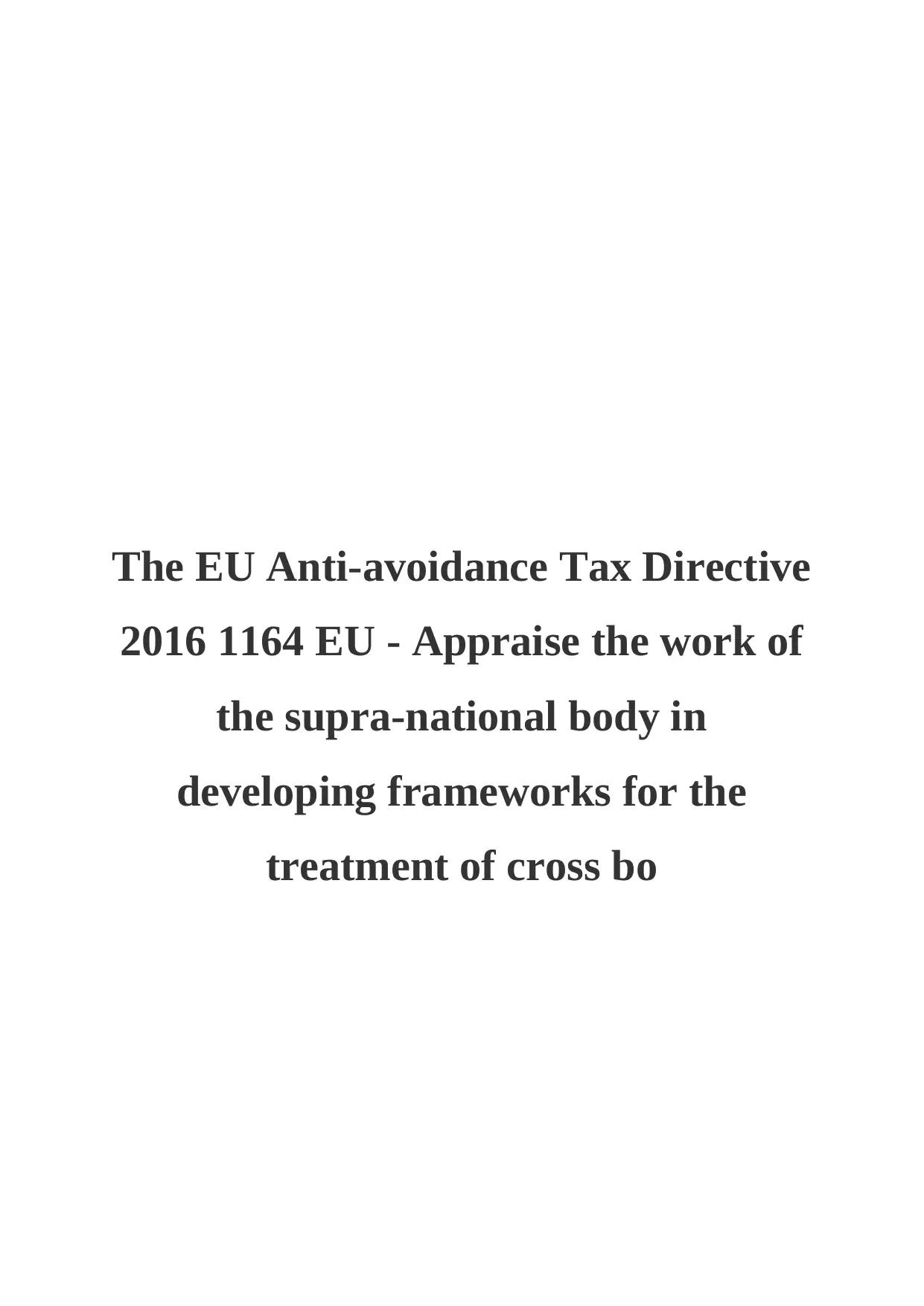
The EU Anti-avoidance Tax Directive
2016 1164 EU - Appraise the work of
the supra-national body in
developing frameworks for the
treatment of cross bo
2016 1164 EU - Appraise the work of
the supra-national body in
developing frameworks for the
treatment of cross bo
Paraphrase This Document
Need a fresh take? Get an instant paraphrase of this document with our AI Paraphraser

Table of Contents
INTRODUCTION.................................................................................................................................3
LO3.......................................................................................................................................................3
The European Union Anti avoidance tax directives...........................................................................3
CONCLUSION.....................................................................................................................................6
REFERENCES......................................................................................................................................6
INTRODUCTION.................................................................................................................................3
LO3.......................................................................................................................................................3
The European Union Anti avoidance tax directives...........................................................................3
CONCLUSION.....................................................................................................................................6
REFERENCES......................................................................................................................................6
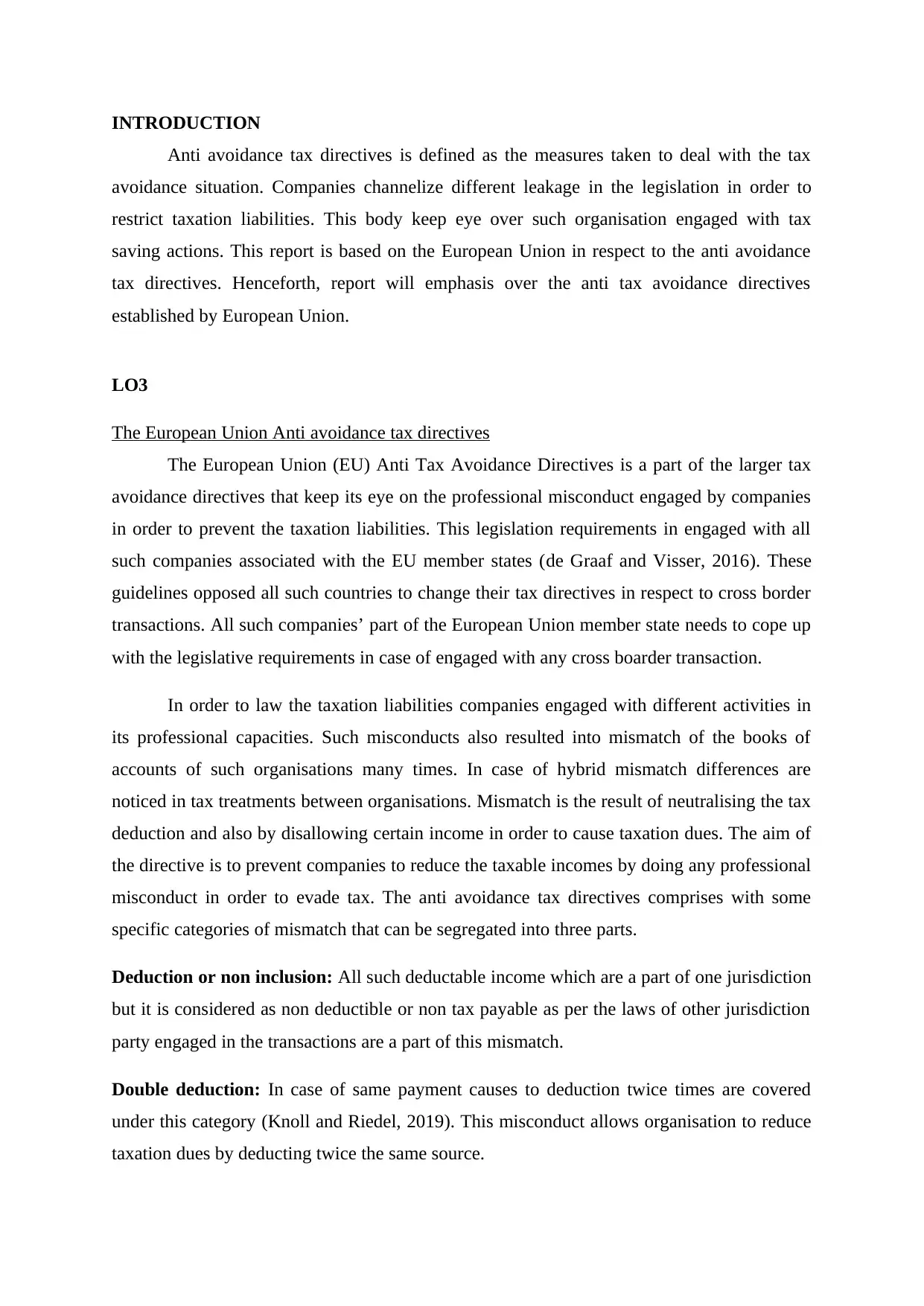
INTRODUCTION
Anti avoidance tax directives is defined as the measures taken to deal with the tax
avoidance situation. Companies channelize different leakage in the legislation in order to
restrict taxation liabilities. This body keep eye over such organisation engaged with tax
saving actions. This report is based on the European Union in respect to the anti avoidance
tax directives. Henceforth, report will emphasis over the anti tax avoidance directives
established by European Union.
LO3
The European Union Anti avoidance tax directives
The European Union (EU) Anti Tax Avoidance Directives is a part of the larger tax
avoidance directives that keep its eye on the professional misconduct engaged by companies
in order to prevent the taxation liabilities. This legislation requirements in engaged with all
such companies associated with the EU member states (de Graaf and Visser, 2016). These
guidelines opposed all such countries to change their tax directives in respect to cross border
transactions. All such companies’ part of the European Union member state needs to cope up
with the legislative requirements in case of engaged with any cross boarder transaction.
In order to law the taxation liabilities companies engaged with different activities in
its professional capacities. Such misconducts also resulted into mismatch of the books of
accounts of such organisations many times. In case of hybrid mismatch differences are
noticed in tax treatments between organisations. Mismatch is the result of neutralising the tax
deduction and also by disallowing certain income in order to cause taxation dues. The aim of
the directive is to prevent companies to reduce the taxable incomes by doing any professional
misconduct in order to evade tax. The anti avoidance tax directives comprises with some
specific categories of mismatch that can be segregated into three parts.
Deduction or non inclusion: All such deductable income which are a part of one jurisdiction
but it is considered as non deductible or non tax payable as per the laws of other jurisdiction
party engaged in the transactions are a part of this mismatch.
Double deduction: In case of same payment causes to deduction twice times are covered
under this category (Knoll and Riedel, 2019). This misconduct allows organisation to reduce
taxation dues by deducting twice the same source.
Anti avoidance tax directives is defined as the measures taken to deal with the tax
avoidance situation. Companies channelize different leakage in the legislation in order to
restrict taxation liabilities. This body keep eye over such organisation engaged with tax
saving actions. This report is based on the European Union in respect to the anti avoidance
tax directives. Henceforth, report will emphasis over the anti tax avoidance directives
established by European Union.
LO3
The European Union Anti avoidance tax directives
The European Union (EU) Anti Tax Avoidance Directives is a part of the larger tax
avoidance directives that keep its eye on the professional misconduct engaged by companies
in order to prevent the taxation liabilities. This legislation requirements in engaged with all
such companies associated with the EU member states (de Graaf and Visser, 2016). These
guidelines opposed all such countries to change their tax directives in respect to cross border
transactions. All such companies’ part of the European Union member state needs to cope up
with the legislative requirements in case of engaged with any cross boarder transaction.
In order to law the taxation liabilities companies engaged with different activities in
its professional capacities. Such misconducts also resulted into mismatch of the books of
accounts of such organisations many times. In case of hybrid mismatch differences are
noticed in tax treatments between organisations. Mismatch is the result of neutralising the tax
deduction and also by disallowing certain income in order to cause taxation dues. The aim of
the directive is to prevent companies to reduce the taxable incomes by doing any professional
misconduct in order to evade tax. The anti avoidance tax directives comprises with some
specific categories of mismatch that can be segregated into three parts.
Deduction or non inclusion: All such deductable income which are a part of one jurisdiction
but it is considered as non deductible or non tax payable as per the laws of other jurisdiction
party engaged in the transactions are a part of this mismatch.
Double deduction: In case of same payment causes to deduction twice times are covered
under this category (Knoll and Riedel, 2019). This misconduct allows organisation to reduce
taxation dues by deducting twice the same source.
⊘ This is a preview!⊘
Do you want full access?
Subscribe today to unlock all pages.

Trusted by 1+ million students worldwide
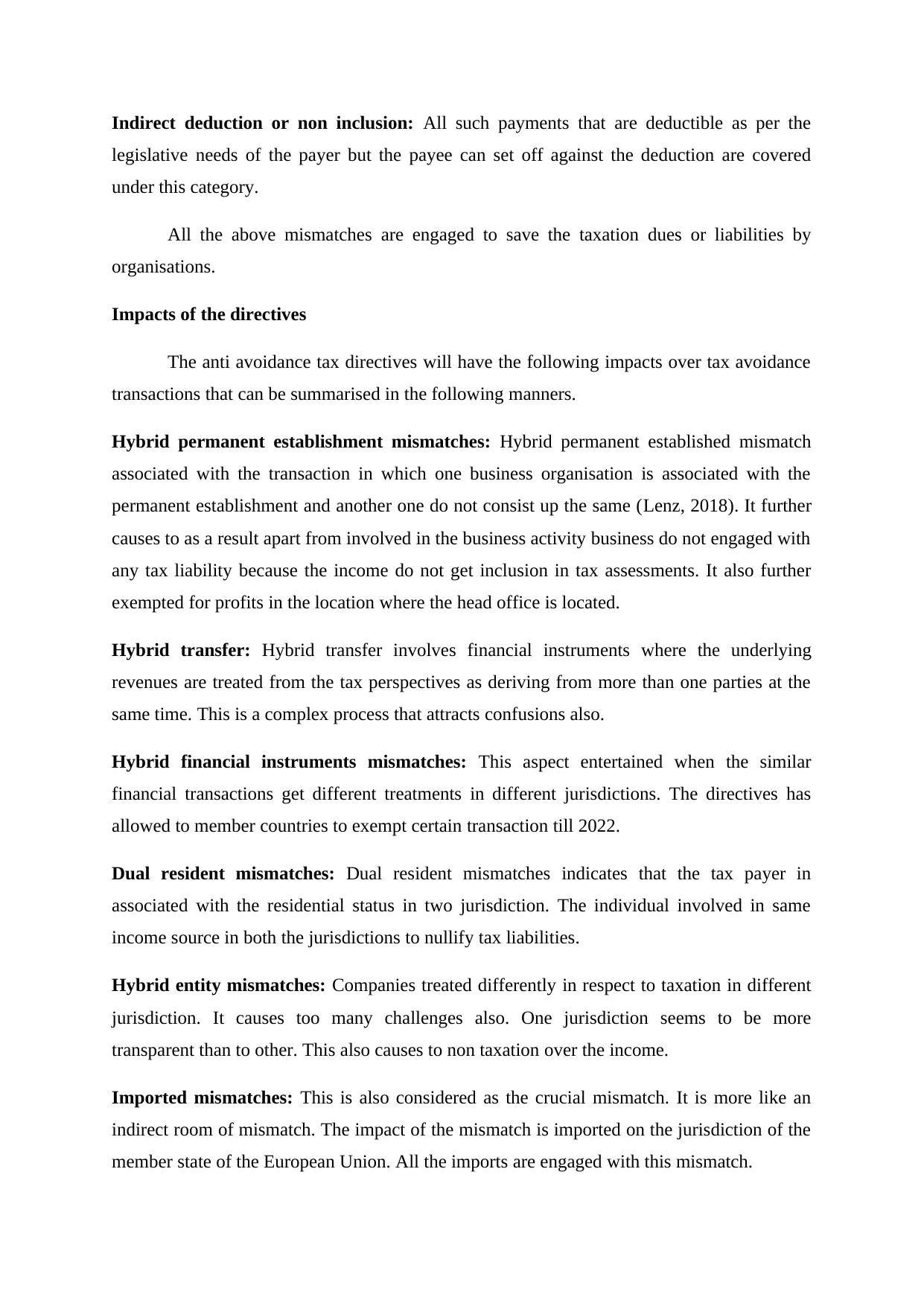
Indirect deduction or non inclusion: All such payments that are deductible as per the
legislative needs of the payer but the payee can set off against the deduction are covered
under this category.
All the above mismatches are engaged to save the taxation dues or liabilities by
organisations.
Impacts of the directives
The anti avoidance tax directives will have the following impacts over tax avoidance
transactions that can be summarised in the following manners.
Hybrid permanent establishment mismatches: Hybrid permanent established mismatch
associated with the transaction in which one business organisation is associated with the
permanent establishment and another one do not consist up the same (Lenz, 2018). It further
causes to as a result apart from involved in the business activity business do not engaged with
any tax liability because the income do not get inclusion in tax assessments. It also further
exempted for profits in the location where the head office is located.
Hybrid transfer: Hybrid transfer involves financial instruments where the underlying
revenues are treated from the tax perspectives as deriving from more than one parties at the
same time. This is a complex process that attracts confusions also.
Hybrid financial instruments mismatches: This aspect entertained when the similar
financial transactions get different treatments in different jurisdictions. The directives has
allowed to member countries to exempt certain transaction till 2022.
Dual resident mismatches: Dual resident mismatches indicates that the tax payer in
associated with the residential status in two jurisdiction. The individual involved in same
income source in both the jurisdictions to nullify tax liabilities.
Hybrid entity mismatches: Companies treated differently in respect to taxation in different
jurisdiction. It causes too many challenges also. One jurisdiction seems to be more
transparent than to other. This also causes to non taxation over the income.
Imported mismatches: This is also considered as the crucial mismatch. It is more like an
indirect room of mismatch. The impact of the mismatch is imported on the jurisdiction of the
member state of the European Union. All the imports are engaged with this mismatch.
legislative needs of the payer but the payee can set off against the deduction are covered
under this category.
All the above mismatches are engaged to save the taxation dues or liabilities by
organisations.
Impacts of the directives
The anti avoidance tax directives will have the following impacts over tax avoidance
transactions that can be summarised in the following manners.
Hybrid permanent establishment mismatches: Hybrid permanent established mismatch
associated with the transaction in which one business organisation is associated with the
permanent establishment and another one do not consist up the same (Lenz, 2018). It further
causes to as a result apart from involved in the business activity business do not engaged with
any tax liability because the income do not get inclusion in tax assessments. It also further
exempted for profits in the location where the head office is located.
Hybrid transfer: Hybrid transfer involves financial instruments where the underlying
revenues are treated from the tax perspectives as deriving from more than one parties at the
same time. This is a complex process that attracts confusions also.
Hybrid financial instruments mismatches: This aspect entertained when the similar
financial transactions get different treatments in different jurisdictions. The directives has
allowed to member countries to exempt certain transaction till 2022.
Dual resident mismatches: Dual resident mismatches indicates that the tax payer in
associated with the residential status in two jurisdiction. The individual involved in same
income source in both the jurisdictions to nullify tax liabilities.
Hybrid entity mismatches: Companies treated differently in respect to taxation in different
jurisdiction. It causes too many challenges also. One jurisdiction seems to be more
transparent than to other. This also causes to non taxation over the income.
Imported mismatches: This is also considered as the crucial mismatch. It is more like an
indirect room of mismatch. The impact of the mismatch is imported on the jurisdiction of the
member state of the European Union. All the imports are engaged with this mismatch.
Paraphrase This Document
Need a fresh take? Get an instant paraphrase of this document with our AI Paraphraser
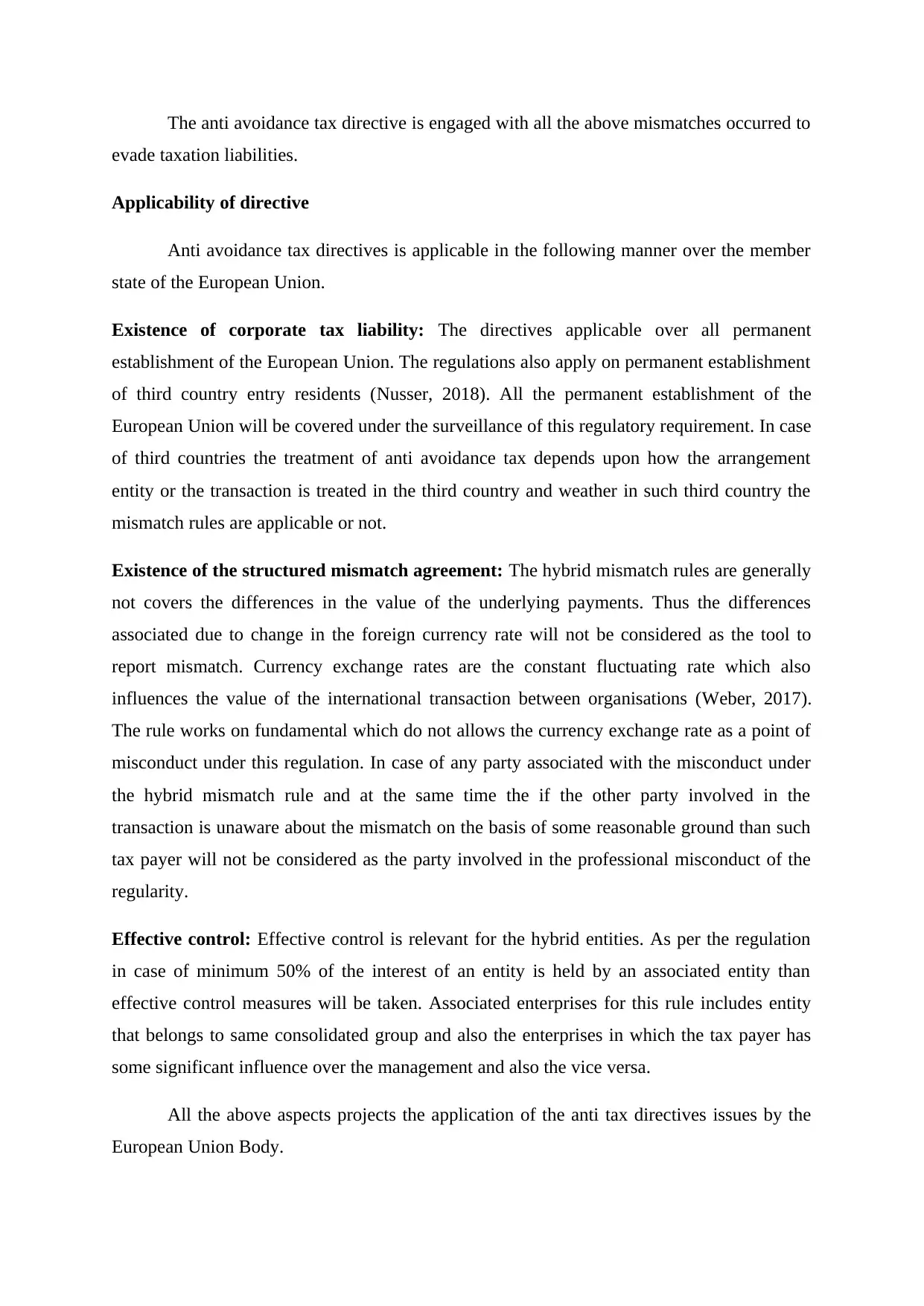
The anti avoidance tax directive is engaged with all the above mismatches occurred to
evade taxation liabilities.
Applicability of directive
Anti avoidance tax directives is applicable in the following manner over the member
state of the European Union.
Existence of corporate tax liability: The directives applicable over all permanent
establishment of the European Union. The regulations also apply on permanent establishment
of third country entry residents (Nusser, 2018). All the permanent establishment of the
European Union will be covered under the surveillance of this regulatory requirement. In case
of third countries the treatment of anti avoidance tax depends upon how the arrangement
entity or the transaction is treated in the third country and weather in such third country the
mismatch rules are applicable or not.
Existence of the structured mismatch agreement: The hybrid mismatch rules are generally
not covers the differences in the value of the underlying payments. Thus the differences
associated due to change in the foreign currency rate will not be considered as the tool to
report mismatch. Currency exchange rates are the constant fluctuating rate which also
influences the value of the international transaction between organisations (Weber, 2017).
The rule works on fundamental which do not allows the currency exchange rate as a point of
misconduct under this regulation. In case of any party associated with the misconduct under
the hybrid mismatch rule and at the same time the if the other party involved in the
transaction is unaware about the mismatch on the basis of some reasonable ground than such
tax payer will not be considered as the party involved in the professional misconduct of the
regularity.
Effective control: Effective control is relevant for the hybrid entities. As per the regulation
in case of minimum 50% of the interest of an entity is held by an associated entity than
effective control measures will be taken. Associated enterprises for this rule includes entity
that belongs to same consolidated group and also the enterprises in which the tax payer has
some significant influence over the management and also the vice versa.
All the above aspects projects the application of the anti tax directives issues by the
European Union Body.
evade taxation liabilities.
Applicability of directive
Anti avoidance tax directives is applicable in the following manner over the member
state of the European Union.
Existence of corporate tax liability: The directives applicable over all permanent
establishment of the European Union. The regulations also apply on permanent establishment
of third country entry residents (Nusser, 2018). All the permanent establishment of the
European Union will be covered under the surveillance of this regulatory requirement. In case
of third countries the treatment of anti avoidance tax depends upon how the arrangement
entity or the transaction is treated in the third country and weather in such third country the
mismatch rules are applicable or not.
Existence of the structured mismatch agreement: The hybrid mismatch rules are generally
not covers the differences in the value of the underlying payments. Thus the differences
associated due to change in the foreign currency rate will not be considered as the tool to
report mismatch. Currency exchange rates are the constant fluctuating rate which also
influences the value of the international transaction between organisations (Weber, 2017).
The rule works on fundamental which do not allows the currency exchange rate as a point of
misconduct under this regulation. In case of any party associated with the misconduct under
the hybrid mismatch rule and at the same time the if the other party involved in the
transaction is unaware about the mismatch on the basis of some reasonable ground than such
tax payer will not be considered as the party involved in the professional misconduct of the
regularity.
Effective control: Effective control is relevant for the hybrid entities. As per the regulation
in case of minimum 50% of the interest of an entity is held by an associated entity than
effective control measures will be taken. Associated enterprises for this rule includes entity
that belongs to same consolidated group and also the enterprises in which the tax payer has
some significant influence over the management and also the vice versa.
All the above aspects projects the application of the anti tax directives issues by the
European Union Body.
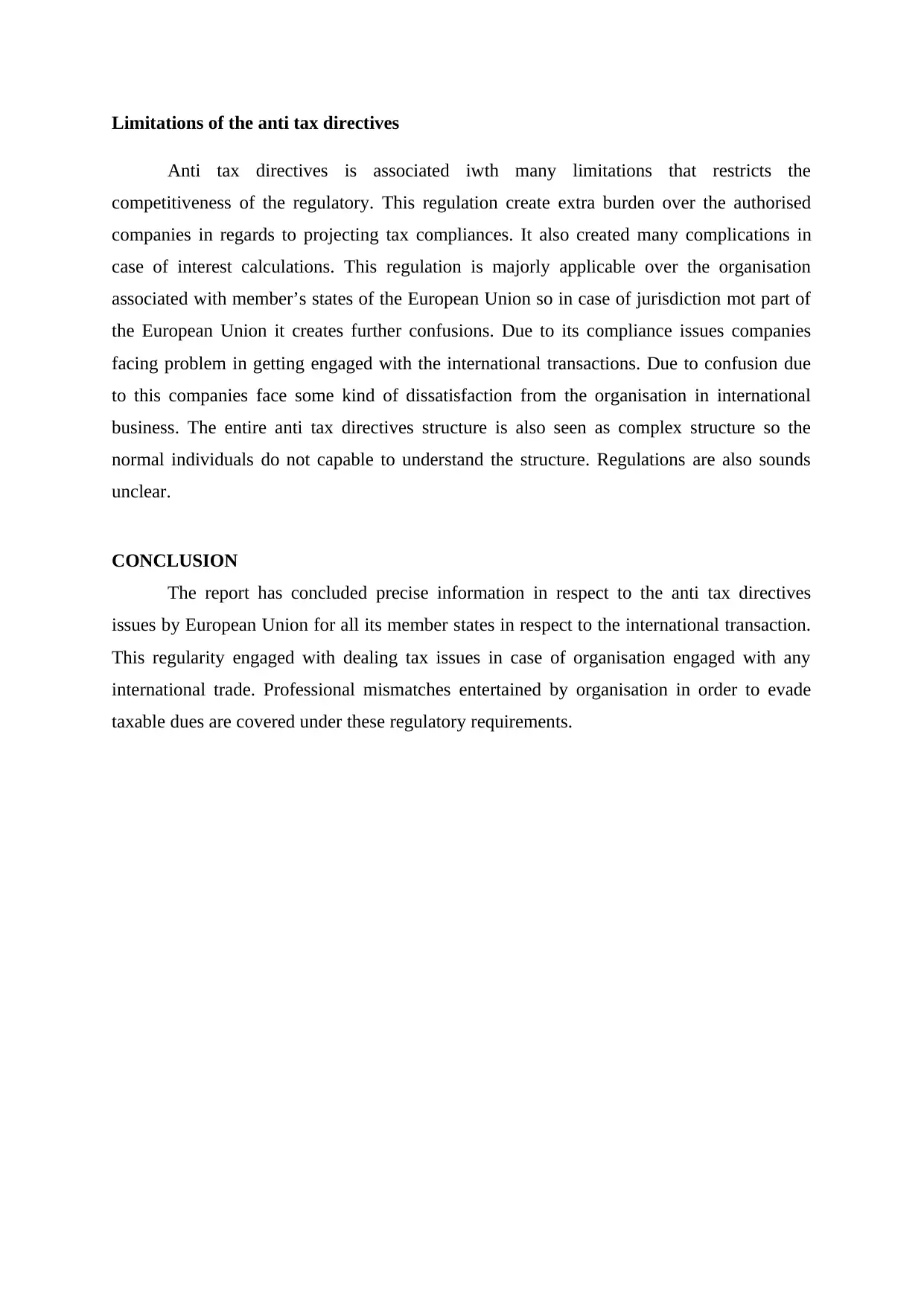
Limitations of the anti tax directives
Anti tax directives is associated iwth many limitations that restricts the
competitiveness of the regulatory. This regulation create extra burden over the authorised
companies in regards to projecting tax compliances. It also created many complications in
case of interest calculations. This regulation is majorly applicable over the organisation
associated with member’s states of the European Union so in case of jurisdiction mot part of
the European Union it creates further confusions. Due to its compliance issues companies
facing problem in getting engaged with the international transactions. Due to confusion due
to this companies face some kind of dissatisfaction from the organisation in international
business. The entire anti tax directives structure is also seen as complex structure so the
normal individuals do not capable to understand the structure. Regulations are also sounds
unclear.
CONCLUSION
The report has concluded precise information in respect to the anti tax directives
issues by European Union for all its member states in respect to the international transaction.
This regularity engaged with dealing tax issues in case of organisation engaged with any
international trade. Professional mismatches entertained by organisation in order to evade
taxable dues are covered under these regulatory requirements.
Anti tax directives is associated iwth many limitations that restricts the
competitiveness of the regulatory. This regulation create extra burden over the authorised
companies in regards to projecting tax compliances. It also created many complications in
case of interest calculations. This regulation is majorly applicable over the organisation
associated with member’s states of the European Union so in case of jurisdiction mot part of
the European Union it creates further confusions. Due to its compliance issues companies
facing problem in getting engaged with the international transactions. Due to confusion due
to this companies face some kind of dissatisfaction from the organisation in international
business. The entire anti tax directives structure is also seen as complex structure so the
normal individuals do not capable to understand the structure. Regulations are also sounds
unclear.
CONCLUSION
The report has concluded precise information in respect to the anti tax directives
issues by European Union for all its member states in respect to the international transaction.
This regularity engaged with dealing tax issues in case of organisation engaged with any
international trade. Professional mismatches entertained by organisation in order to evade
taxable dues are covered under these regulatory requirements.
⊘ This is a preview!⊘
Do you want full access?
Subscribe today to unlock all pages.

Trusted by 1+ million students worldwide

REFERENCES
Books and Journals
de Graaf, A. and Visser, K. J., 2016. ATA Directive: Some Observations Regarding Formal
Aspects. EC Tax Rev. 25. p.199.
Knoll, B. and Riedel, N., 2019. Patent Shifting and Anti-Tax Avoidance Legislation. DICE
Report. 17(4). pp.25-29.
Lenz, H., 2018. Aggressive tax avoidance by managers of multinational companies as a
violation of their moral duty to obey the law: a kantian rationale. Journal of Business
Ethics. pp.1-17.
Nusser, H., 2018. Profit shifting within multinationals: an analysis of its tax-minimization
potential and of anti-avoidance measures that extend taxation of interest and
royalties at source (Doctoral dissertation).
Weber, D. ed., 2017. EU Law and the Building of Global Supranational Tax Law.
Books and Journals
de Graaf, A. and Visser, K. J., 2016. ATA Directive: Some Observations Regarding Formal
Aspects. EC Tax Rev. 25. p.199.
Knoll, B. and Riedel, N., 2019. Patent Shifting and Anti-Tax Avoidance Legislation. DICE
Report. 17(4). pp.25-29.
Lenz, H., 2018. Aggressive tax avoidance by managers of multinational companies as a
violation of their moral duty to obey the law: a kantian rationale. Journal of Business
Ethics. pp.1-17.
Nusser, H., 2018. Profit shifting within multinationals: an analysis of its tax-minimization
potential and of anti-avoidance measures that extend taxation of interest and
royalties at source (Doctoral dissertation).
Weber, D. ed., 2017. EU Law and the Building of Global Supranational Tax Law.
1 out of 7
Your All-in-One AI-Powered Toolkit for Academic Success.
+13062052269
info@desklib.com
Available 24*7 on WhatsApp / Email
![[object Object]](/_next/static/media/star-bottom.7253800d.svg)
Unlock your academic potential
Copyright © 2020–2025 A2Z Services. All Rights Reserved. Developed and managed by ZUCOL.
